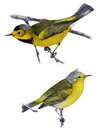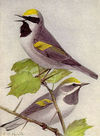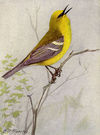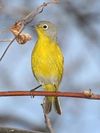Genus Vermivora
Bachman's wood warbler - Bachman's Warbler is possibly extinct, and was most likely never common. The last confirmed sightings were in 1988 and before that in 1961 in South Carolina. The Bachman's Warbler's last stronghold was in I'on Swamp, South Carolina. Habitat destruction was probably the main cause of its disappearance. Its extinction is not yet officially announced, because habitat remaining in Congaree National Park needs to be surveyed. Furthermore, on January 14, 2002, a bird reminiscent of a female Bachman's Warbler was filmed at Guardalavaca, Cuba. As Vermivora warblers are not known to live more than about 7 years, if the identification is correct it would imply that a breeding population managed to survive undiscovered for decades.
Orange-crowned Warbler - The Orange-crowned Warbler is a small songbird of the New World warbler family.
Golden-winged Warbler - The Golden-winged Warbler, Vermivora chrysoptera, is a New World warbler, 11.6 cm long and weighing 8.5 g. It breeds in eastern North America in southeastern Canada and the eastern USA. Its range is extending northwards, but in the south it is being replaced by the very closely related Blue-winged Warbler, Vermivora pinus.
Colima warbler - The Colima warbler is about 4.5 to 5 inches in length. They are mainly dark gray and brownish in coloration, with a pale under-side. Their rump and the feathers below their tail are yellow. They have a white ring around their eye, and a tinge of pale color on their breasts. Males have a spot of orange on the top of their heads.
Lucy's warbler - It is rather nondescript compared to other wood-warblers. Its head and upperparts are pale gray, while underparts are whitish. It has a white eyering and a small, pointed bill. Both sexes have a rufous rump, a diagnostic field mark. Adult males also have a small rusty crown patch. Juveniles are paler, with a tawny rump and buffy wingbars.
Tennessee Warbler - The Tennessee Warbler, Vermivora peregrina, is a New World warbler. It breeds in northern North America across Canada and the northern USA. It is migratory, wintering in southern Central America and northern Colombia and Venezuela, with a few stragglers going as far south as Ecuador. It is a very rare vagrant to western Europe. This bird was named from a specimen collected in Tennessee where it may appear during migration.
Blue-winged Warbler - The Blue-winged Warbler, Vermivora pinus, is a fairly common New World warbler, 11.5 cm long and weighing 8.5 g. It breeds in eastern North America in southern Ontario and the eastern USA. Its range is extending northwards, where it is replacing the very closely related Golden-winged Warbler, Vermivora chrysoptera.
Nashville Warbler - The Nashville Warbler, Vermivora ruficapilla, is a small songbird in the New World warbler family.
Virginia's warbler - Despite what its name may suggest, Virginia's warbler is not actually named after the American State of Virginia, which makes sense as the birds range only reaches as far east as the state of Texas. The bird's common eastern range is central and southern mountains of Colorado, central Wyoming, and central and western New Mexico. The bird was named for Virginia Anderson, the wife of an army surgeon who discovered the bird at Fort Burgwin, New Mexico, in 1858. When Spencer Fullerton Baird of the Smithsonian Institution fully described the bird for science in 1860 he honored the wishes of the warbler's discoverer and designated Virginia to be both the bird's common and scientific name.







